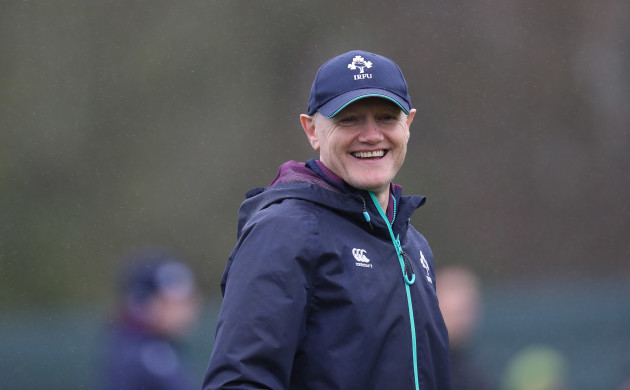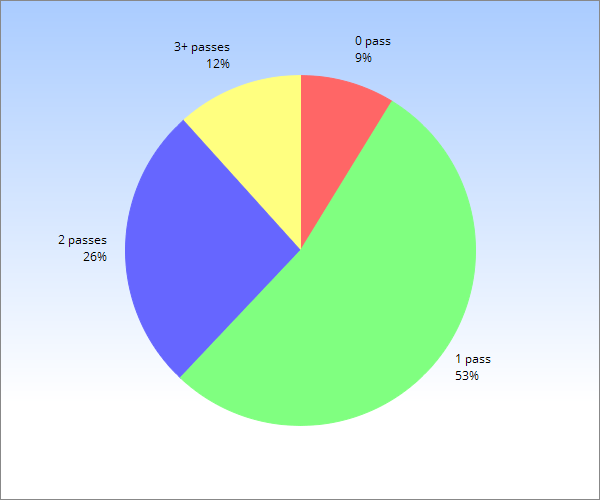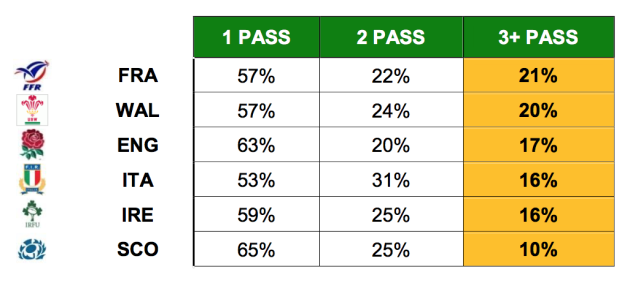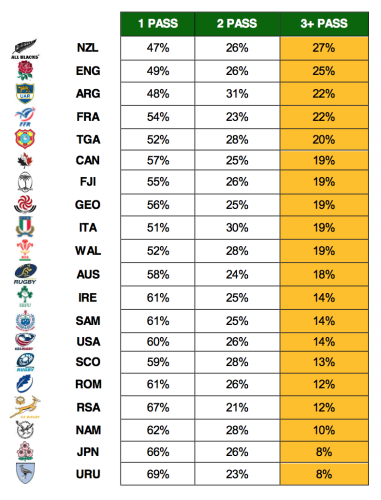JOE SCHMIDT REACTED strongly to suggestions that his Ireland side are overly reliant on one-out phases in attack yesterday.
“What is the percentage of one-out runners?” came Schmidt’s reply to a query about how he views those opinions on his team’s style of play.
It’s a good question from Schmidt and while it’s not one we can answer completely comprehensively, there are some statistics to look at in this case.
The42‘s analysis of Ireland’s defeat to Scotland in the first round of this year’s Six Nations shows that Schmidt’s men had just one pass on 73 of their 137 phases in possession, not including their kicking game.
That is, Ireland used one pass on 53% of their phases.
There were a further 12 phases where Ireland did not pass at all – think of one of the forwards making a pick and jam, or Conor Murray sniping at the fringes of the ruck.
That means a total of 62% of phases where Ireland used zero or one pass.
Below, we see that data from the Scotland game plotted onto a pie chart.
Schmidt did state yesterday that the percentage of one-out runners for Ireland “is a lot less than second handling.”
While it’s not clear whether he meant a second pass by using the term ‘second handling,’ the data above shows that Ireland’s percentage of one-pass phases is far higher than two-pass phases. The data that follows below underlines that fact.
Analysis carried out by superb The Chase blog after Ireland’s win over Australia in the November Tests showed that Ireland’s attack in that game consisted of zero-pass or one-pass phases 65% of the time.
If we go back a little further to the 2016 Six Nations, we can draw on more statistics in this area.
The official data for last year’s tournament shows that Ireland’s so-called “passing movements” involved one-pass phases 59% of the time.
There is no data for zero-pass phases, which must be stressed here.
However, the overall figure for one-pass phases is slightly higher than what we saw in the 2017 Six Nations clash Scotland, so it’s safe to say that if we were to add in zero-pass phases, the figure would be higher than the 62% from that Scotland game.
Taking us further back in time, World Rugby’s figures for the 2015 Rugby World Cup show that Ireland’s one-pass phases were higher again.
Ireland’s one-pass phases in this instance were 61%.
Again, it is safe to say that were we to add in zero-pass phases – we don’t have that data – the figure for a combined zero-pass and one-pass phases would be higher than the 2017 Six Nations clash with Scotland and also the 2016 Six Nations overall percentage.
What the data does show for certain is that the percentage of Ireland’s one-pass phases has slightly declined from the 2015 World Cup to the 2016 Six Nations and now to the opening game of the 2017 Six Nations [a one-game sample base is obviously not ideal].
The numbers from World Rugby are also useful because they allow us to compare Ireland’s percentage with those of the other sides involved in the competition.
As we can see above, only South Africa, Japan [with Eddie Jones as head coach], Uruguay, and Namibia had higher percentages of one-pass phases than Ireland at the 2015 RWC.
The 2016 Six Nations data shows us that Eddie Jones’ England [note the change from their RWC campaign under Stuart Lancaster] and Scotland had more one-pass phases than Ireland, while Wales and France were just behind Schmidt’s side.
Come the end of the 2017 version of the Six Nations, it would be a major surprise if Ireland’s percentage of one-pass phases was very different to the other competing nations.
The fact is that Ireland’s use of one-out runners is not really very different to any of the other Six Nations sides.
The RWC 2015 statistics underline that the likes of New Zealand and Argentina use far fewer one-out phases, but then most observers could have suggested that with certainty even before viewing any data.
Ireland’s figure of 62% for zero-pass or one-pass phases in the Scotland game is not a particularly high figure compared to what their competitors do, and that percentage almost certainly dropped further in the Italy game, when the weak opposition allowed Ireland to pass and offload more freely.
We will follow these statistics as the current Six Nations progresses, and it will be fascinating to see if the percentage rises as Ireland face the physical power of France, Wales and England.
As Schmidt has admitted, it’s time for knock-out rugby in this Six Nations and it will be intriguing to see if Ireland continue with their more ambitious approach to attack or reel it in and rely more heavily on one-pass and zero-pass phases.
The real litmus test lies ahead.
Subscribe to The42 Rugby Show podcast here:




